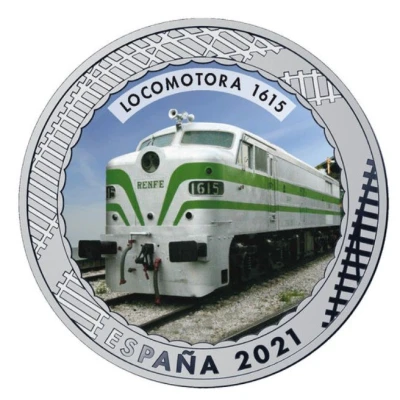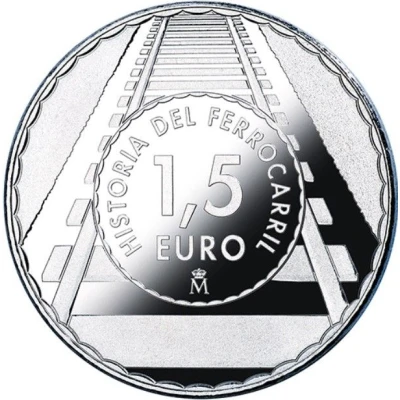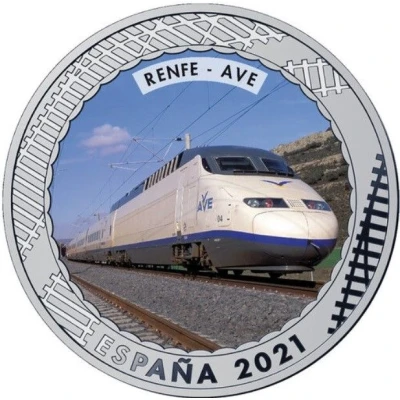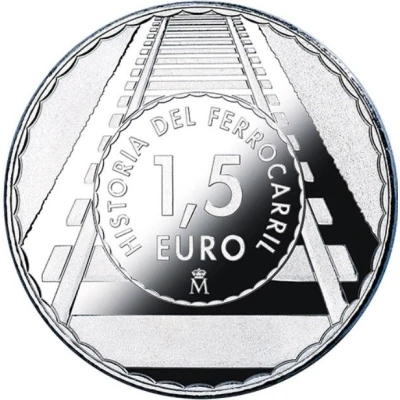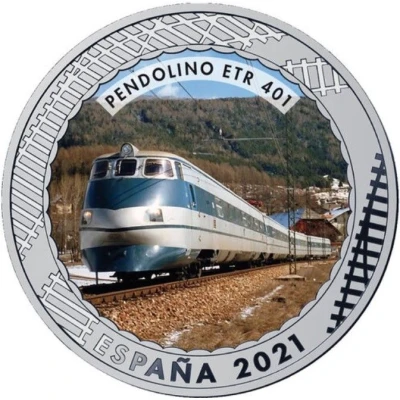
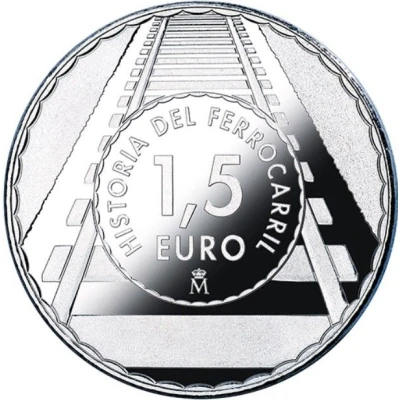

© Real Casa de la Moneda
1.5 Euro Pendolino ETR
2021 year| Copper-nickel (75% copper, 25% nickel) | 15 g | 33 mm |
| Issuer | Spain |
|---|---|
| King | Felipe VI (2014-date) |
| Type | Non-circulating coin |
| Year | 2021 |
| Value | 1.5 Euro 1.50 EUR = USD 1.65 |
| Currency | Euro (2002-date) |
| Composition | Copper-nickel (75% copper, 25% nickel) |
| Weight | 15 g |
| Diameter | 33 mm |
| Shape | Round |
| Technique | Milled, Coloured |
| Orientation | Medal alignment ↑↑ |
| Updated | 2024-10-07 |
| Numista | N#320572 |
|---|---|
| Rarity index | 92% |
Reverse
Series and face value inside a central circle. Outside the central circle, an image of a railway track.
Script: Latin
Lettering:
HISTORIA DEL FERROCARRIL
1,5 EURO
M
Translation: History of railways
Edge
Plain
Comment
For the year 2021, since the European Year of the Rail and the 80th Anniversary of Renfe are celebrated, the FNMT-RCM issues a collection of 20 coins dedicated to the History of the Railways. This series reproduces a selection of trains and locomotives that have been relevant throughout its history.Pendolino ETR 401: Italian railways also became involved in the research undertaken in Europe on the back of the Japanese Bullet Train so as to achieve faster convoys without the need to build new infrastructure. Hence, Ferrovie dello Stato Italiane (Italian State Railways) commissioned Fiat to design the Pendolino, whose main characteristic would be its tilting capacity. This function was regulated by the continuous action of accelerometers and gyroscopes while the pantograph maintained its natural position thanks to its special linkage.
The train was made up of four cars, each equipped with two 335 hp engines, providing a huge amount of power in respect of its low weight of 161 T. With this system, a top speed of 250 km/h could be attained. Another feature of this singular, ground-breaking vehicle lay in the fact that it had three different brake systems: the dynamic one, where the engines were used like dynamos for ordinary use; the electro-pneumatic one, used when travelling at low speeds; and the electromagnetic one, for high speeds.
The Pendolino was put into operation in 1976, covering the Rome-Ancona route on a track 298 km in length, a large part of which runs along mountainous terrain. Despite its special features, it failed to reach top speed in these sections. On the upside, with the tilting system, passengers’ comfort was greatly improved and travel time was far shorter. The Pendolino covered the Rome-Rimini route from 1976 to 1983, when the railway company withdrew it from service because it was found to be no longer profitable.
One of the outcomes of this story is that the Spanish railway company, Renfe, and Fiat entered into an agreement of cooperation to develop a tilting train which, based on the Pendolino, was registered by the Spanish operating company as Series 443-001. Known as the Platanito (Plantain), it made its maiden journey in the summer of 1976.
Interesting fact
The Pendolino ETR 401 coin's design features a high-speed train, symbolizing the connection between Spain and Italy, as the train depicted is capable of reaching speeds of up to 250 km/h (155 mph).
Price
| Date | Mintage | VG | F | VF | XF | AU | UNC |
|---|---|---|---|---|---|---|---|
| 2021 M | 7000 | - | - | - | - | - | - |
Values in the table are based on evaluations by sales realized on Internet platforms. They serve as an indication only for 1.5 Euro (Pendolino ETR 401) 2021 coin.
